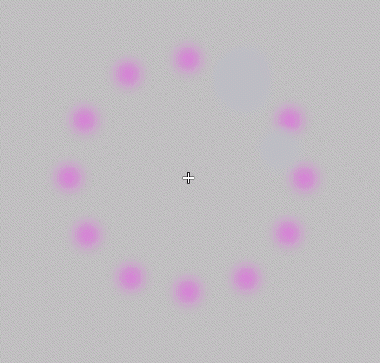Lilac chaser
Lilac chaser is a visual illusion, also known as the Pac-Man illusion, that spread across the Internet in 2005. Lilac chaser is very similar to phi phenomenon, and consists of 12 lilac (or pink or magenta-like), blurred disks arranged in a circle (like the numbers on a clock), around a small, black, central cross on a gray background.
The apparent movement of the lilac chaser and similar phi phenomena is not fully understood, but it has led to significant research into visual perception. In addition to providing ways to research human abilities, illusions like the lilac chaser intrigue and entertain people, reflecting our cognitive curiosity and endless appreciation for creativity that is part of human nature.
Discovery
The illusion was created by Jeremy Hinton some time before 2005. Hinton stumbled across the configuration while devising stimuli for visual motion experiments. In one version of a program to move a disk around a central point, he mistakenly omitted to erase the preceding disk, which created the appearance of a moving gap. Upon noticing the moving green-disk afterimage, he adjusted foreground and background colors, number of disks, and timing in order to optimize the effect. Later, Hinton blurred the disks, allowing them to disappear when a viewer looks steadily at the central cross. Hinton entered the illusion in the ECVP Visual Illusion Contest, but was disqualified for lack of registration. He then approached Michael Bach, who placed it on his web page of illusions[1] and named it. The illusion quickly spread across the internet.
Description
Lilac chaser consists of a group of 12 lilac, blurred disks arranged around a small black cross. Each disk disappears briefly in clockwise order. When staring at the central cross, a viewer first sees a gap rotating around the circle, then a green disk that rotates around the circle, and finally, the disappearance of the lilac disks themselves.
Explanation
The lilac chaser illusion combines three simple, well-known effects:
The first effect (the moving gap) is due to the phi phenomenon. The moving gap creates a sense of apparent motion, similar to the way we perceive a series of still pictures as a moving image in film.
The moving gap becomes a rotating green disk because of afterimages. When the retina is stimulated with a certain color, the cones of the eye react to a loss of stimulus by activating the complimentary color of the stimulus. Adaptation of rods and cones begins immediately when they are stimulated, when afterimages also start to grow. We normally do not notice them because we move our eyes about three times a second. In lilac chaser, we keep our eyes still, so the afterimages grow and are revealed as the stimulus disappears.
The blurred lilac disks disappear because of a phenomena known as Troxler's fading. When a blurry stimulus is presented to a region of the visual field away from where we are fixating, and we keep our eyes still, that stimulus will disappear even though it is still physically present. This occurs because, although our eyes move slightly when we are fixating at a point, in peripheral vision these movements are not large enough to shift the lilac disks to new neurons of the visual system. Their afterimages essentially cancel out the original images, and all one sees of the lilac disks is gray, except for the gap where the green afterimage appears. In fact, it is not necessary to fixate on the cross for the effect; any stationary fixation will work.
These effects combine to yield the remarkable sight of a green spot running around in a circle on a gray background where only stationary, flashing lilac spots occur. Occasionally it may seem as though the green afterimage eats up the lilac disks, giving the illusion its alternative, Pac-Man name.
Applications
Lilac chaser achieved a sort of cult-status on the Internet. Like many other similar illusions, the study of the perceptual effects of the illusion can be useful to scientists in the study of how the brain perceives and interprets visual information.
Notes
- ↑ Michael Bach, Web Page of illusions, Michaelbach.com, 2008. Retrieved January 7, 2007.
ReferencesISBN links support NWE through referral fees
- Blue, Ronald C. 2005. A visual yet non-optical subjective intonation. 13 (3), p. 299 - 300. Electroneurobiología, 2005. Retrieved December 21, 2007.
External links
All links retrieved October 25, 2022.
- Hinton's “Lilac Chaser”
- "Electroneurobiology article" – The ontological nature of the color afterimages has been analyzed in this article, "A visual yet non-optical subjective intonation," by Mariela Szirko.
Credits
New World Encyclopedia writers and editors rewrote and completed the Wikipedia article in accordance with New World Encyclopedia standards. This article abides by terms of the Creative Commons CC-by-sa 3.0 License (CC-by-sa), which may be used and disseminated with proper attribution. Credit is due under the terms of this license that can reference both the New World Encyclopedia contributors and the selfless volunteer contributors of the Wikimedia Foundation. To cite this article click here for a list of acceptable citing formats.The history of earlier contributions by wikipedians is accessible to researchers here:
The history of this article since it was imported to New World Encyclopedia:
Note: Some restrictions may apply to use of individual images which are separately licensed.
